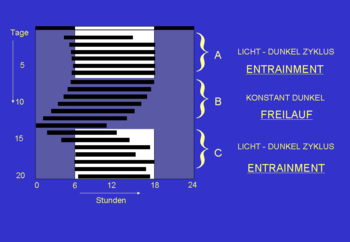Entrainment (biology)
In chronobiology, entrainment is understood as the synchronization of the internal clock with regularly recurring environmental factors, the so-called timers . Entrainment is the biological equivalent of a phase locked loop . The most important timer for circadian rhythms is the change from day to night. Other external timers can be ebb and flow , temperature, or social interaction , for example .
The resulting behavioral patterns are not a direct reaction to the changes in the environment, so they differ from simple stimulus-response patterns. If this is the case, one speaks of masking . The stimulus has a direct effect on the rhythm, but not on the internal clock.
features
To be able to speak of entrainment through a timer, four criteria must be met:
- The circadian rhythm must run freely when the timer is switched off .
- While the rhythm is exposed to the timer, the period of the free-running rhythm must be the same as that of the timer (control of the period).
- There must be a fixed phase relation between the timer and the perceived rhythm (possibly anticipation).
- When the timer disappears, the freely running rhythm must show a phase that follows the phase that the rhythm had when the timer was still in effect.
Actogram
The graphic shows the activity of a diurnal animal on consecutive days ( y-axis ), each recorded from midnight to midnight ( x-axis ). This form of representation is called an actogram.
The observed animal was kept under the following light conditions:
- Period A (day 1-6): light-dark cycle (light on 6 a.m., light off 6 p.m.) = LD 12/12
- Period B (days 7-13): permanent darkness
- Period C (days 14-20): again LD 12/12
The black bars indicate the activity of the animal.
- Period A: From day 2, the animal is synchronized with the light timer, i.e. entrained.
- Period B: In permanent darkness there is a free run with a circadian period shorter than 24 hours. That is, the animal starts its activity a little earlier each day.
- Period C: After the light timer has been switched on, the animal is largely synchronized with the timer again within two days, i.e. it is entrained.
